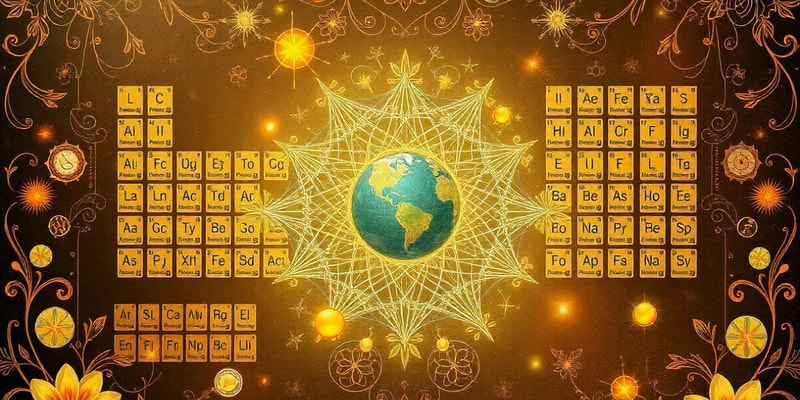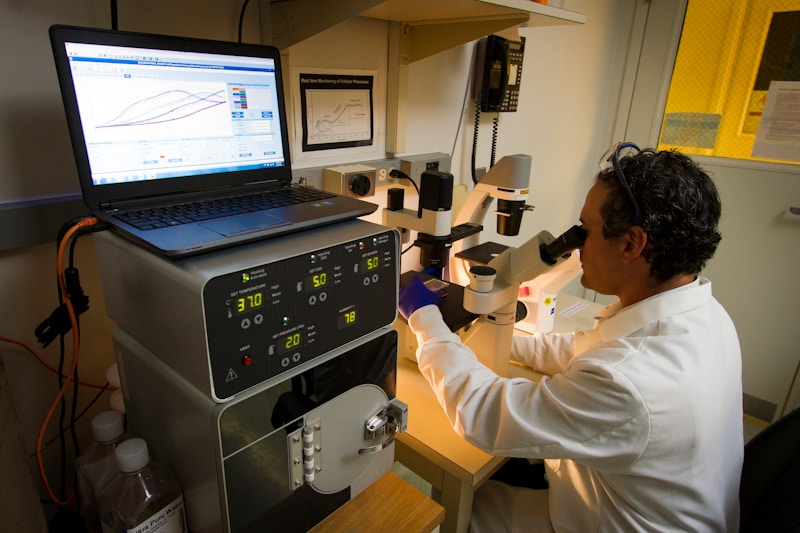Podcast
Questions and Answers
Which subatomic particle was discovered by James Chadwick?
Which subatomic particle was discovered by James Chadwick?
What is the primary characteristic of isotopes?
What is the primary characteristic of isotopes?
Which particle is located in the nucleus and has a positive charge?
Which particle is located in the nucleus and has a positive charge?
What does the atomic number (Z) signify in an atom?
What does the atomic number (Z) signify in an atom?
Signup and view all the answers
Which of the following elements has an atomic number of 79?
Which of the following elements has an atomic number of 79?
Signup and view all the answers
What is the approximate mass of a hydrogen atom?
What is the approximate mass of a hydrogen atom?
Signup and view all the answers
Which term describes the percentage of a specific isotope found in a sample?
Which term describes the percentage of a specific isotope found in a sample?
Signup and view all the answers
Which of the following correctly describes the mass number (A)?
Which of the following correctly describes the mass number (A)?
Signup and view all the answers
What is the charge of an electron?
What is the charge of an electron?
Signup and view all the answers
Which scientist proposed the existence of the atomic nucleus?
Which scientist proposed the existence of the atomic nucleus?
Signup and view all the answers
What is the significance of the mass number A in isotopes?
What is the significance of the mass number A in isotopes?
Signup and view all the answers
How is the average atomic mass of an element calculated?
How is the average atomic mass of an element calculated?
Signup and view all the answers
What does the symbol for Deuterium represent?
What does the symbol for Deuterium represent?
Signup and view all the answers
Which statement is true regarding Tritium?
Which statement is true regarding Tritium?
Signup and view all the answers
What element is represented by the symbol 12 C?
What element is represented by the symbol 12 C?
Signup and view all the answers
What is the average atomic mass of carbon, calculated using the isotopic abundances of carbon-12 and carbon-13?
What is the average atomic mass of carbon, calculated using the isotopic abundances of carbon-12 and carbon-13?
Signup and view all the answers
What does it mean if an isotope's abundance is very low, such as Tritium's?
What does it mean if an isotope's abundance is very low, such as Tritium's?
Signup and view all the answers
Which isotopes of carbon are stable?
Which isotopes of carbon are stable?
Signup and view all the answers
What is the value of one atomic mass unit (1 u) in grams?
What is the value of one atomic mass unit (1 u) in grams?
Signup and view all the answers
In the instance of Carbon-13, how does its composition differ from Carbon-12?
In the instance of Carbon-13, how does its composition differ from Carbon-12?
Signup and view all the answers
How many atoms are present in one mole of any element?
How many atoms are present in one mole of any element?
Signup and view all the answers
Why are isotopes typically named by writing their mass number after the element name?
Why are isotopes typically named by writing their mass number after the element name?
Signup and view all the answers
What would be the molar mass of 1 mole of gold (Au) in grams?
What would be the molar mass of 1 mole of gold (Au) in grams?
Signup and view all the answers
What is the number of neutrons in the isotope Carbon-13?
What is the number of neutrons in the isotope Carbon-13?
Signup and view all the answers
Which statement about isotopes is correct?
Which statement about isotopes is correct?
Signup and view all the answers
What is the relationship between molar mass and average atomic mass?
What is the relationship between molar mass and average atomic mass?
Signup and view all the answers
What is the total number of neutrons in a single atom of Carbon-12?
What is the total number of neutrons in a single atom of Carbon-12?
Signup and view all the answers
What is the formula to calculate the number of moles in a substance?
What is the formula to calculate the number of moles in a substance?
Signup and view all the answers
Which of the following elements is not considered a noble gas?
Which of the following elements is not considered a noble gas?
Signup and view all the answers
Which term correctly defines elements that have the same number of valence electrons and similar chemical properties?
Which term correctly defines elements that have the same number of valence electrons and similar chemical properties?
Signup and view all the answers
What characteristic distinguishes metals from non-metals in chemical properties?
What characteristic distinguishes metals from non-metals in chemical properties?
Signup and view all the answers
Which of the following is not classified as an alkaline earth metal?
Which of the following is not classified as an alkaline earth metal?
Signup and view all the answers
In the periodic table, which block contains the transition metals?
In the periodic table, which block contains the transition metals?
Signup and view all the answers
Which group in the periodic table is characterized by having elements with similar properties and includes fluorine and chlorine?
Which group in the periodic table is characterized by having elements with similar properties and includes fluorine and chlorine?
Signup and view all the answers
What is the primary chemical property of alkali metals such as sodium and potassium?
What is the primary chemical property of alkali metals such as sodium and potassium?
Signup and view all the answers
Identify the element that is incorrectly matched with its Latin-based symbol.
Identify the element that is incorrectly matched with its Latin-based symbol.
Signup and view all the answers
Which of the following best describes an s-block element?
Which of the following best describes an s-block element?
Signup and view all the answers
Which element is represented by the symbol 'Hg'?
Which element is represented by the symbol 'Hg'?
Signup and view all the answers
Study Notes
Atomic Structure
- The smallest particle of an element that maintains the chemical properties of that element is called an atom.
- An element is comprised of atoms that share the same chemical properties.
- Sb, Cu, Au, Fe, Pb, Hg, K, Ag, Na, Sn, and W are element symbols derived from Latin and German names.
Periodic Table
- The periodic table arranges elements into vertical columns called groups and horizontal rows called periods.
- Elements in the same group are called congeners.
- Alkali metals make up Group I (Na, Li, K, Rb, Cs).
- Alkaline earth metals make up Group II (Be, Ca, Mg, Sr, Ba).
- Halogens make up Group VII (F, Cl, Br, I).
- Noble gases make up Group VIII (Kr, He, Ne, Xe, Rn).
- Transition metals are located between Groups II and III.
- s-block elements refer to Groups I and II.
- p-block elements refer to Groups III to VIII.
- d-block elements refer to transition metals.
- f-block elements refer to lanthanides and actinides.
Minerals in Multivitamins & Baby Formula
- Calcium (Ca)
- Phosphorus (P)
- Magnesium (Mg)
- Iron (Fe)
- Zinc (Zn)
- Manganese (Mn)
- Copper (Cu)
- Iodine (I)
- Selenium (Se)
- Sodium (Na)
- Potassium (K)
- Chlorine (Cl)
General Information
- A metal is a substance that conducts electricity, has a metallic luster, and is malleable and ductile.
- A non-metal is a substance that does not conduct electricity and is neither malleable nor ductile.
- A metalloid has the physical appearance and properties of a metal but chemically acts like a non-metal. Silicon (Si), Germanium (Ge), Arsenic (As), and Tellurium (Te) are examples.
Atomic Components
- Electrons were discovered by J.J. Thomson.
- Electrons have one negative charge (e–), a charge of 1.6 x 10–19 coulombs (C), and a mass of 9.1 x 10–28 grams.
- Protons were discovered by James Chadwick.
- Protons have one positive charge (p+). They are approximately 1836 times heavier than an electron.
- Protons are located in the nucleus.
- Neutrons are neutral. They are located in the nucleus.
- The nucleus is the positively charged center of the atom where protons and neutrons reside. It was proposed by Ernest Rutherford.
Atomic Number, Mass Number, and Average Atomic Mass
- The atomic number (Z) is the quantity of protons in the nucleus. It is written above the chemical symbol.
- An atom is electrically neutral, its number of protons must equal the number of electrons.
- Mass number (A) is the sum of protons and neutrons: A=Z+N
- The mass of an atom is measured by mass spectrometry.
- Isotopes are atoms with the same atomic number but different masses due to a variation in the number of neutrons.
- Isotopic abundance is the percentage of an isotope in a sample.
- Natural abundance refers to the abundance of an isotope in a natural sample.
- Average atomic mass (also called atomic weight) is the average relative mass of an element, taking into account the natural abundance of its isotopes.
- Relative atomic mass is a comparison of an atom's mass with the mass of one atom of carbon-12.
- 1 atomic mass unit (u) is equivalent to 1/12 the mass of a carbon-12 atom.
The Mole and Molar Mass
- 1 mole of atoms of any element contains Avogadro’s number (NA) of atoms, which is 6.022 x 1023.
- 1 mole of carbon-12 is 12 grams.
- The molar mass of an element or compound is the mass of 1 mole expressed in grams.
- The molar mass of an element is numerically equal to the average atomic mass in atomic mass units (amu).
- For example, 1 mole of gold (Au) has a mass of 196.97 grams, 1 mole of copper (Cu) is 63.54 grams, and 1 mole of mercury (Hg) is 200.59 grams.
Studying That Suits You
Use AI to generate personalized quizzes and flashcards to suit your learning preferences.
Related Documents
Description
This quiz covers fundamental concepts in atomic structure and the periodic table. It explores the characteristics of atoms, chemical symbols, and the arrangement of elements into groups and periods. Understanding these concepts is essential for grasping advanced chemistry topics.




